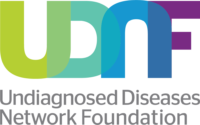05 Oct Inside Look into the UDN Vanderbilt Site: Interviews with Dr. Phillips and Dr. Hamid
By Ashley McMinn | October 5, 2022
Following the success of the Undiagnosed Diseases Network (UDN) at Vanderbilt University Medical Center (VUMC), the medical center is now establishing their own clinical program aimed at solving complex medical mysteries, the Vanderbilt Undiagnosed Diseases Program (VUDP). Launched in April 2021 under the direction of Rizwan Hamid, MD, PhD, the VUDP works alongside the current UDN team to expand access to services to the 1 in 10 patients currently estimated to be affected by a rare and/or undiagnosed disease. Guided by the success of VUMC’s NIH-funded program, the VUDP combines the expertise of both clinical and research specialists, partnering with several multidisciplinary collaborators across VUMC’s campus and providing patients access to VUMC’s state-of-the-art resources and genetic analysis pipelines.
The program’s mission is to help end diagnostic odysseys for patients and their families, while advancing medical knowledge of undiagnosed diseases through the continued collaboration of dedicated geneticists, specialists, and scientists across the VUMC enterprise. Fueled by a sense of urgency to serve this patient population, Hamid says, “Our goal is to use the best science and Vanderbilt’s unique research tools to help patients today.”
Since its inception, the program has received over 90 applications from approximately 20 different states across the country. VUMC, who was named a National Organization for Rare Disorders (NORD) Center of Excellence in 2021, strongly believes that programs like the UDN and the VUDP are an essential and underrepresented service for these patients. The team’s aim is to continue to expand the program to provide these essential services to more adults and children whose symptoms have not led other clinicians to diagnoses.
Criteria for acceptance is similar to that of the UDN, and applicants must be referred by a medical provider for consideration. In addition, accepted patients pay an administrative fee which covers facets of the program not currently billable to insurance. The program relies on insurance billing for those services that are available clinically, so prospective applicants are encouraged to contact their insurance company to discuss coverage for services received at VUMC. One of the unique aspects of this program is the available institutional funding which makes it possible to use all available research methodologies (advanced genomics, animal models, drug discovery) to help solve cases and identify treatments without additional cost to the patient. Thus, the program is able to offer the same research aspects as if it were NIH-funded.
The VUDP team members include Rizwan Hamid, MD, PhD, Dorothy O. Wells Professor of Pediatrics, John Phillips, MD, David T. Karzon Professor of Pediatrics and professor of Biochemistry, Medicine, and Pathology; John Fahrenholz, MD, assistant professor of Medicine; Kevin Byram, MD, assistant professor of Medicine; Craig Sussman, professor of Clinical Medicine; Joy Cogan, PhD, professor of Pediatrics; Lisa Bastarache, MS, research assistant professor of Biomedical Informatics; Brian Corner, MS, CGC; Mary Koziura, DNP, FNP-BC; Ashley McMinn, MHSA; and Toni Carver, LPN.
For more information about the Vanderbilt Undiagnosed Diseases Program, including contact information and how to apply, please visit:
https://www.vanderbilthealth.com/undiagnosed.
——–
This month, UDN Site Coordinator, Anna Bican, sat down with the two clinical Principal Investigators at the Vanderbilt Clinical Site (John A. Phillips, III MD and Rizwan Hamid, MD, PhD) to get their thoughts on the collaborative spirit of their site and special reflections on favorite UDN cases that are the hallmark of the UDN successes there.
“People are always looking to make some sense of why this happened. I think a great benefit from the UDN is that when we are able to find a genetic and biological basis of something, we have an explanation – this is what happened, or this is what caused it. Either you were a carrier, or your husband was a carrier, or this was a new mutation – this wasn’t that you drove too fast or said bad words that made this happen. This is the risk we all have.” – John A. Phillips, III MD
Click here to watch Anna Bican’s interview with Dr. John A. Phillips, III
“That story [COG4 Saul Wilson syndrome] stands out to me because it showed the wonderful collaborative spirit of the UDN program which is, I think, the strength of this network that is what the PEER group understands, and our families understand. We have 12 clinical sites, and in the case of the UDN 1+1+1 times the number of UDN clinical sites, doesn’t equal 12; it equals 1 MILLION! The synergy that develops in the UDN is such an amazing resource.” – Rizwan Hamid, MD, PhD
Click here to watch Anna Bican’s interview with Dr. Rizwan Hamid



